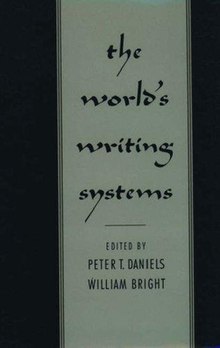In punctuation, a word divider is a glyph that separates written words. In languages which use the Latin, Cyrillic, and Arabic alphabets, as well as other scripts of Europe and West Asia, the word divider is a blank space, or whitespace. This convention is spreading, along with other aspects of European punctuation, to Asia and Africa, where words are usually written without word separation.
Peter T. Daniels is a scholar of writing systems, specializing in typology. He was co-editor of the book The World's Writing Systems (1996). He was a lecturer at University of Wisconsin–Milwaukee and Chicago State University.

Clear Script is an alphabet created in 1648 by the Oirat Buddhist monk Zaya Pandita for the Oirat language. It was developed on the basis of the Mongolian script with the goal of distinguishing all sounds in the spoken language, and to make it easier to transcribe Sanskrit and the Tibetic languages.
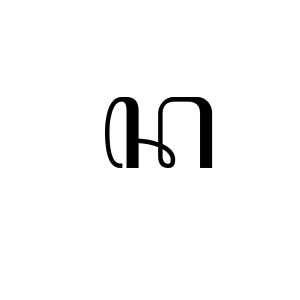
ꦤ is one of syllable in Javanese script that represent the sound /nɔ/, /na/. It is transliterated to Latin as "na", and sometimes in Indonesian orthography as "no". It has another form (pasangan), which is ◌꧀ꦤ, but represented by a single Unicode code point, U+A9A4.
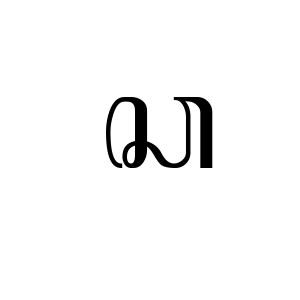
ꦕ is one of syllable in Javanese script that represent the sound /tʃɔ/, /tʃa/. It is transliterated to Latin as "ca", and sometimes in Indonesian orthography as "co". It has another form (pasangan), which is ◌꧀ꦕ, but represented by a single Unicode code point, U+A995.
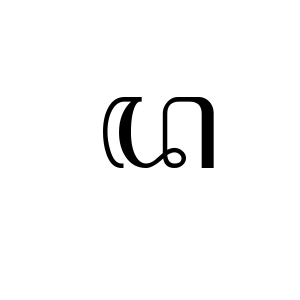
ꦢ is a syllable in the Javanese script that represent the sound /d̪ɔ/, /d̪a/. It is transliterated to Latin as "da", and sometimes in Indonesian orthography as "do". It has another form (pasangan), which is ◌꧀ꦢ, but represented by a single Unicode code point, U+A9A2.

ꦮ is one of syllable in Javanese script that represent the sound /ʋɔ/, /ʋa/. It is transliterated to Latin as "wa", and sometimes in Indonesian orthography as "wo". It has another form (pasangan), which is ◌꧀ꦮ, but represented by a single Unicode code point, U+A9B3.

ꦭ is one of syllable in Javanese script that represent the sound /lɔ/, /la/. It is transliterated to Latin as "la", and sometimes in Indonesian orthography as "lo". It has two other forms (pasangan), which are ◌꧀ꦭ and ◌꧀ꦭꦸ, but represented by a single Unicode code point, U+A9AD.
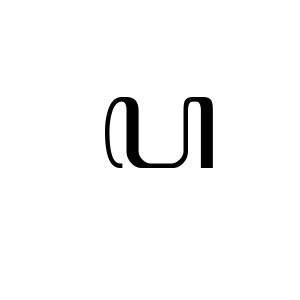
ꦥ is one of syllable in Javanese script that represent the sound /pɔ/, /pa/. It is transliterated to Latin as "pa", and sometimes in Indonesian orthography as "po". It has another form (pasangan), which is ◌꧀ꦥ, but represented by a single Unicode code point, U+A9A5.
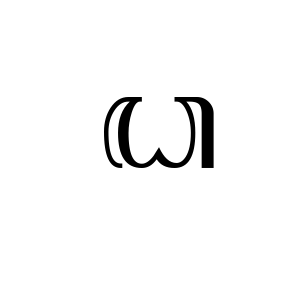
ꦝ is one of syllable in Javanese script that represent the sound /ɖɔ/, /ɖa/. It is transliterated to Latin as "dha", and sometimes in Indonesian orthography as "dho". It has another form (pasangan), which is ◌꧀ꦝ, but represented by a single Unicode code point, U+A99D.
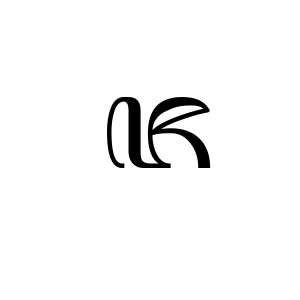
ꦗ is one of syllable in Javanese script that represent the sound /dʒɔ/, /dʒa/. It is transliterated to Latin as "ja" or "ya", and sometimes in Indonesian orthography as "jo" or "yo". It has another form (pasangan), which is ◌꧀ꦗ, but represented by a single Unicode code point, U+A997.

ꦪ is one of syllable in Javanese script that represent the sound /jɔ/, /ja/. It is transliterated to Latin as "ya", and sometimes in Indonesian orthography as "yo". It has another form (pasangan), which is ◌꧀ꦪ, but represented by a single Unicode code point, U+A9AA.
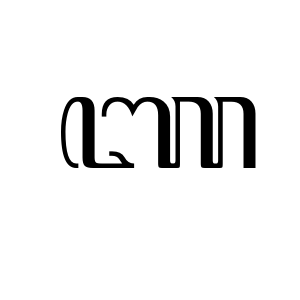
ꦚ is one of syllable in Javanese script that represent the sound /ɲɔ/, /ɲa/. It is transliterated to Latin as "nya", and sometimes in Indonesian orthography as "nyo". It has another form (pasangan), which is ◌꧀ꦚ, but represented by a single Unicode code point, U+A99A.

ꦩ is one of the syllables in Javanese script that represents the sound /mɔ/, /ma/. It is transliterated to Latin as "ma", and sometimes in Indonesian orthography as "mo". It has another form (pasangan), which is ◌꧀ꦩ, but represented by a single Unicode code point, U+A9A9.

ꦒ is one of syllable in Javanese script that represent the sound /ɡɔ/, /ɡa/. It is transliterated to Latin as "ga", and sometimes in Indonesian orthography as "go". It has another form (pasangan), which is ◌꧀ꦒ, but represented by a single Unicode code point, U+A992.

ꦧ is a syllable in the Javanese script that represents the sound /bɔ/, /ba/. It is transliterated into Latin as "ba" and sometimes in Indonesian orthography as "bo". It has another form (pasangan), ◌꧀ꦧ, but is represented by a single Unicode code point, U+A9A7.
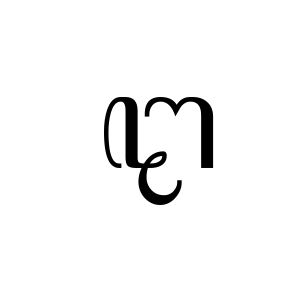
ꦛ is one of syllable in Javanese script that represent the sound /ʈɔ/, /ʈa/. It is transliterated to Latin as "tha", and sometimes in Indonesian orthography as "tho". It has another form (pasangan), which is ◌꧀ꦛ, but represented by a single Unicode code point, U+A99B.

ꦔ is one of syllable in Javanese script that represent the sound /ŋɔ/, /ŋa/. It is transliterated to Latin as "nga", and sometimes in Indonesian orthography as "ngo". It has another form (pasangan), which is ◌꧀ꦔ, but represented by a single Unicode code point, U+A994.

The Palmyrene alphabet was a historical Semitic alphabet used to write Palmyrene Aramaic. It was used between 100 BCE and 300 CE in Palmyra in the Syrian desert. The oldest surviving Palmyrene inscription dates to 44 BCE. The last surviving inscription dates to 274 CE, two years after Palmyra was sacked by Roman Emperor Aurelian, ending the Palmyrene Empire. Use of the Palmyrene language and script declined, being replaced with Greek and Latin.
The Elymaic alphabet is a right-to-left, non-joining abjad. It is derived from the Aramaic alphabet. Elymaic was used in the ancient state of Elymais, which was a semi-independent state of the 2nd century BCE to the early 3rd century CE, frequently a vassal under Parthian control, in the present-day region of Khuzestan, Iran (Susiana).
